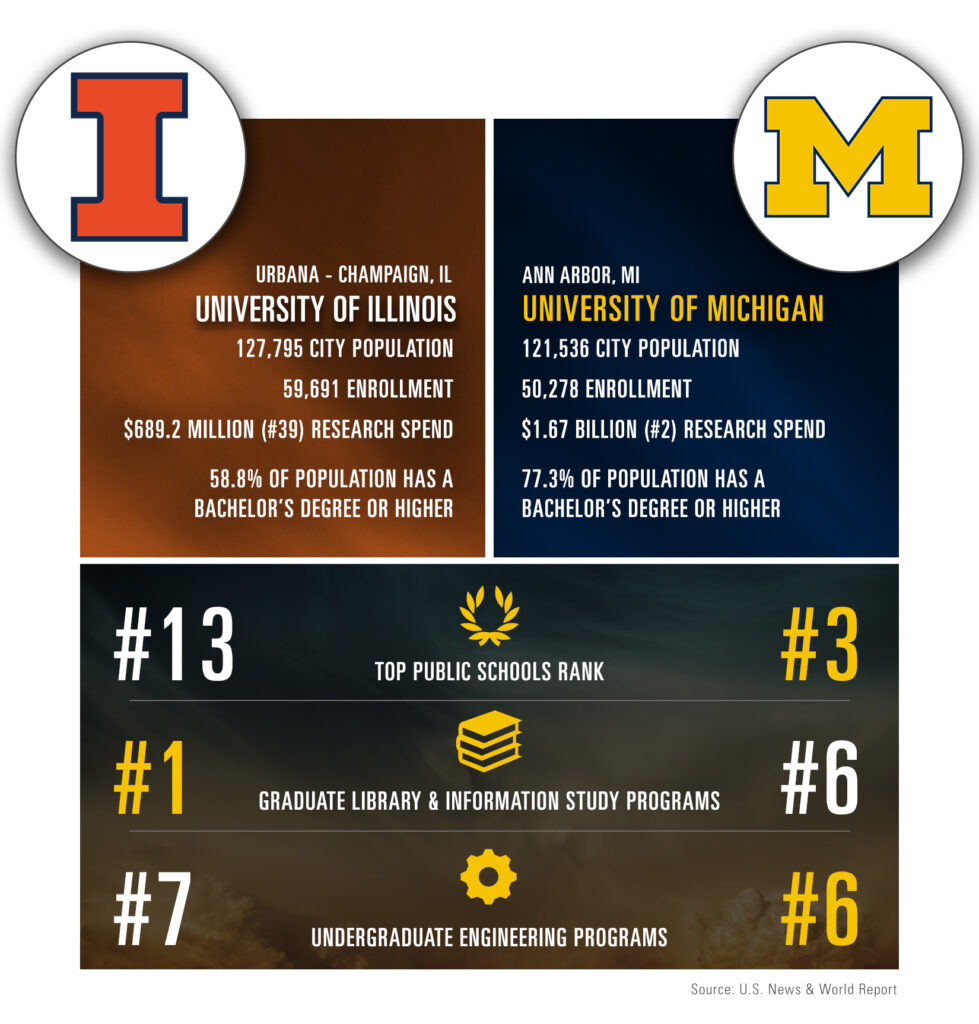
Week 12: Saturday, November 19, 2022 | Michigan vs. Illinois | Michigan Stadium | Noon EST
Ann Arbor SPARK’s popular football blog series is back for Michigan’s 143rd season! We use the football season as an opportunity to compare Ann Arbor to cities around the country represented by our U-M football competition. The question is always – how does Ann Arbor compare to other college towns in the U.S.?
Michigan enters this weekend’s matchup with a 10-0 record for the first time since 2006. On Saturday, Michigan will host the Fighting Illini for the 97th time in history (Michigan leads the longstanding series 71-23-2). The first time these two teams met was in 1898. To put that in perspective, at that time McKinley was president, the U.S. had just annexed Hawaii, the Treaty of Paris ended the Spanish-American War, and Marie and Pierre Curie announced the discovery of an element they called radium.
Bringing us back to the present day, the two college towns of Ann Arbor and Urbana-Champaign are quite similar, though Urbana-Champaign presents a slight challenge since they are technically twin cities (or metros that have grown into each other over time, losing their mutual buffer zone). As such, calculating the population gets tricky, so we’ve decided to sum them up and call it one city.

Fun fact: The University is home to The Research Park at the University of Illinois — a technology hub that cultivates startups and accelerates corporate innovation. Located on campus, the Research Park has more than 120 companies, employing over 2,100 people in high-technology careers. In addition, The Research Park is home to EnterpriseWorks, a 43,000-square-foot business incubator for early-stage tech firms housing 50+ startups. This model is slightly different from U-M, who works closely with SPARK and other startup incubators affiliated with the university to commercialize technology and create companies right here at home.
The cost of living is relatively low in Urbana-Champaign (98.3 compared to 100.4 in Ann Arbor) and, not shockingly, the median household income is also lower in Urbana-Champaign ($62,464 compared to $75,730 in Ann Arbor). As of September 2022, Champaign County reported an unemployment rate of 3.6 percent, which is on par with the rate of 3.3 percent here in Washtenaw County. Ann Arbor’s educational attainment is hard to top with 77 percent of the population possessing a bachelor’s degree or higher, but Urbana-Champaign holds its own with nearly 60 percent of its population possessing a bachelor’s degree or higher.
Be on the lookout for our blog posts ahead of each game all season long and be sure to tag us when you share these interesting tidbits with your friends via social media! And, if you want more information like this or are curious to learn more about the Ann Arbor region and what makes it such a great place to live, work, and locate your business in, please reach out to our Director of Research, Melissa Sheldon.
In case you missed it, here are links to the regional comparisons we’ve posted so far this year:
- Week 1: Ann Arbor vs. Fort Collins
- Week 2: Ann Arbor vs. Honolulu
- Week 3: Ann Arbor vs. Storrs Mansfield
- Week 4: Ann Arbor vs. College Park
- Week 5: Ann Arbor vs. Iowa City
- Week 6: Ann Arbor vs. Bloomington
- Week 7: Ann Arbor vs. State College
- Week 8: Bye Week
- Week 9: Ann Arbor vs. East Lansing
- Week 10: Ann Arbor vs. New Brunswick
- Week 11: Ann Arbor vs. Lincoln
Sources
Where do we get our numbers? And what do they mean?
- Population data comes from the U.S. Census, 2021 Population Estimates. Check out Ann Arbor’s data.
- Enrollment data comes from the Integrated Postsecondary Education Data System (IPEDS). Review University of Michigan data.
- Research expenditure data comes from the National Science Foundation. View the Rankings by Total R&D Expenditures.
- Educational attainment data comes from the US Census 2016-2020 American Community Survey Five-Year Estimates. We look specifically at the population over the age of 25, and the highest level attained. Check out Ann Arbor’s data.
- The rankings come from U.S. News and World Report unless otherwise noted.